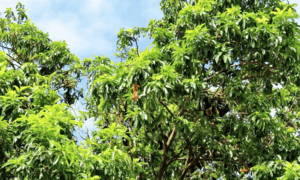Brush box facts for kids
Quick facts for kids Brush box |
|
|---|---|
 |
|
| Scientific classification | |
| Genus: |
Lophostemon
|
| Species: |
confertus
|
| Synonyms | |
|
|
The Brush Box (scientific name: Lophostemon confertus) is a type of evergreen tree. This means it keeps its leaves all year round. It comes from Australia, but you can also find it growing in the United States and other places.
People call it by many names, like Queensland Box, Brisbane Box, or Pink Box. In Australia, it naturally grows in north-east New South Wales and along the coast of Queensland. It's a very popular street tree in big cities like Sydney and Melbourne.
What Does It Look Like?
In the wild, the Brush Box tree can grow very tall, sometimes over 40 metres (about 130 feet). It grows in moist forests and near rainforests. However, if it grows on windy coastal areas, it might be shorter and more spread out.
This tree has a round, dome-like shape. Its leaves are dark green and feel a bit like leather. Because it has so many dense leaves, it gives a lot of shade. It's also considered safer than eucalyptus trees because its branches rarely break off.
Why Is It a Good Street Tree?
The Brush Box is a great choice for planting along streets. It's very strong and can handle many tough conditions. It doesn't get sick easily and pests usually leave it alone. It can also deal with smog, dry weather, and poor drainage. Plus, it doesn't need a lot of care.
Even if it needs to be trimmed to avoid power lines, it grows back well. This tree is often used instead of the Camphor Laurel, which can spread too easily. The Brush Box is one of the toughest and most successful street trees in places like Sydney.
How Was It Named?
A Scottish botanist named Robert Brown first officially described this tree in 1812. He found the plant in the Hunter River area of New South Wales. Brown first named it Tristania confertia. Later, in 1982, scientists moved it to a new group of plants called Lophostemon.
Gallery
See also
 In Spanish: Boj cepillo para niños
In Spanish: Boj cepillo para niños



